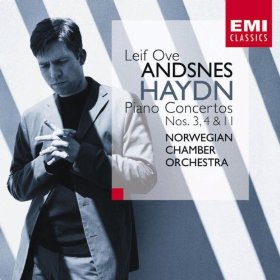Haydn Piano Concertos 3, 4 & 11
A rewarding trio of rarely encountered piano [concerto] concertos given sparkling advocacy by Andsnes and his Norwegian ensemble
View record and artist detailsRecord and Artist Details
Composer or Director: Joseph Haydn
Label: EMI
Magazine Review Date: 4/2000
Media Format: CD or Download
Media Runtime: 54
Mastering:
DDD
Catalogue Number: 556960-2

Tracks:
| Composition | Artist Credit |
|---|---|
| Concerto for Keyboard and Orchestra |
Joseph Haydn, Composer
Joseph Haydn, Composer Leif Ove Andsnes, Piano Norwegian Chamber Orchestra |
Author: Richard Osborne
EMI's timing is exquisite. As Berowne says in Love's Labour's Lost: 'At Christmas I no more desire a rose/Than wish snow in May's new- fangled mirth'. This brilliant, charming, occasionally profound collection of Haydn piano concertos is very much a spring release, perfect matter for a May morning.
Like Emanuel Ax on the rival Sony CD, Leif Ove Andsnes confines himself to the three concertos that have been fully authenticated. Had the works generally known as 'the Haydn piano concertos' been these three and not a rag-bag of juvenilia and pieces attributed to Haydn, the canon might have been more highly thought of than has often been the case.
That said, even the slightest work can dazzle and delight if it is performed as well as these are here. Where Ax's performances have a slightly monochrome feel to them, everything tapped out (there is much audible fingerwork) with the same well-adjusted mix of energy and sensibility, Andsnes's playing is altogether more various while at the same time being perfectly at one with itself stylistically.
In the D major Concerto, the most familiar of the works but a dullish piece if it is unimaginatively played, the spirit of Eulenspiegel shines through Andsnes's performance, the playing lithe, witty, wonderfully various. No one who enjoys early Beethoven shrewdly and wittily played - the finale of the B flat Concerto or the Op 3 Piano Sonatas - could fail to enjoy this.
Ax's Franz Liszt Chamber Orchestra is the more idiomatic of the two ensembles in the D major Concerto'sRondo all'Ungarese but that is just about the only occasion on which it has the edge over Andsnes's stylish and highly articulate Norwegian Chamber Orchestra; and, even here, Andsnes himself scores points for a less noisy plunge into the interlude in D minor and a more sunlit and finely flighted way with the episode which follows.
The Norwegian players are never afraid to play full out, a strategy which the explicit but carefully balanced recording is happy to underwrite. Thus the players make much of the 'look here, young man' chromaticisms in the first movement of the D major Concerto as the piano chatters irrepressibly on; and they contribute decisively to the superbly articulated - nay, revelatory - performance of the G major Concerto with which the disc begins.
After a splendidly jaunty account of the first movement, Andsnes pushes this G major Concerto to its limits with a skilfully shaped account of the glooming C major slow movement which is slower than Ax's, and a dashing account of the concluding Presto which is even quicker. By contrast, Andsnes's playing of the Largo cantabile of the F major Concerto - the concerto's centrepiece andraison d'etre - is the very embodiment of sweetness and light. A marvellous disc.'
Like Emanuel Ax on the rival Sony CD, Leif Ove Andsnes confines himself to the three concertos that have been fully authenticated. Had the works generally known as 'the Haydn piano concertos' been these three and not a rag-bag of juvenilia and pieces attributed to Haydn, the canon might have been more highly thought of than has often been the case.
That said, even the slightest work can dazzle and delight if it is performed as well as these are here. Where Ax's performances have a slightly monochrome feel to them, everything tapped out (there is much audible fingerwork) with the same well-adjusted mix of energy and sensibility, Andsnes's playing is altogether more various while at the same time being perfectly at one with itself stylistically.
In the D major Concerto, the most familiar of the works but a dullish piece if it is unimaginatively played, the spirit of Eulenspiegel shines through Andsnes's performance, the playing lithe, witty, wonderfully various. No one who enjoys early Beethoven shrewdly and wittily played - the finale of the B flat Concerto or the Op 3 Piano Sonatas - could fail to enjoy this.
Ax's Franz Liszt Chamber Orchestra is the more idiomatic of the two ensembles in the D major Concerto's
The Norwegian players are never afraid to play full out, a strategy which the explicit but carefully balanced recording is happy to underwrite. Thus the players make much of the 'look here, young man' chromaticisms in the first movement of the D major Concerto as the piano chatters irrepressibly on; and they contribute decisively to the superbly articulated - nay, revelatory - performance of the G major Concerto with which the disc begins.
After a splendidly jaunty account of the first movement, Andsnes pushes this G major Concerto to its limits with a skilfully shaped account of the glooming C major slow movement which is slower than Ax's, and a dashing account of the concluding Presto which is even quicker. By contrast, Andsnes's playing of the Largo cantabile of the F major Concerto - the concerto's centrepiece and
Discover the world's largest classical music catalogue with Presto Music.

Gramophone Digital Club
- Digital Edition
- Digital Archive
- Reviews Database
- Full website access
From £8.75 / month
Subscribe
Gramophone Full Club
- Print Edition
- Digital Edition
- Digital Archive
- Reviews Database
- Full website access
From £11.00 / month
Subscribe
If you are a library, university or other organisation that would be interested in an institutional subscription to Gramophone please click here for further information.




